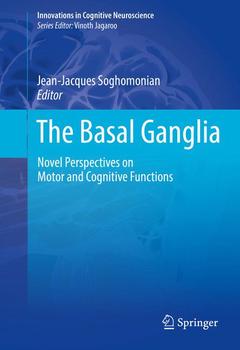The Basal Ganglia, 1st ed. 2016 Novel Perspectives on Motor and Cognitive Functions Innovations in Cognitive Neuroscience Series
Coordonnateur : Soghomonian Jean-Jacques

This groundbreaking text takes current knowledge of the basal ganglia far from well-known motor-based models to a more inclusive understanding of deep-brain structure and function. Synthesizing diverse perspectives from across the brain-behavioral sciences, it tours the neuroanatomy and circuitry of the basal ganglia, linking their organization to their controlling functions in core cognitive, behavioral, and motor areas, both normative and disordered. Interactions between the basal ganglia and major structures of the brain are identified in their contributions to a diverse range of processes, from language processing to decision-making, emotion to visual perception, motivation to intent. And the basal ganglia are intimately involved in the mechanisms of dysfunction, as evinced by chapters on dyskinesia, Parkinson?s disease, neuropsychiatric conditions, and addictions.
Included in the coverage:
- Limbic-basal ganglia circuits: parallel and integrative aspects.
- Dopamine and its actions in the basal ganglia system.
- Cerebellar-basal ganglia interactions.
- The basal ganglia contribution to controlled and automatic processing.
- The basal ganglia and decision making in neuropsychiatric disorders.
- The circuitry underlying the reinstatement of cocaine seeking: modulation by deep brain stimulation.
- The basal ganglia and hierarchical control in voluntary behavior.
Its breadth and depth of scholarship and data should make The Basal Ganglia a work of great interest to cognitive psychologists and neuroscientists, neuropsychologists, neurologists, neuropsychiatrists, and speech-language pathologists.
General organization of the basal ganglia circuitry.- Parallel circuits of the basal ganglia: motor, associative and limbic circuits.- Integrative networks across basal ganglia circuits.- Limbic inputs to the ventral striatum.- Organization of prefrontal-striatal connections.- Subcortical inputs to the basal ganglia: cerebellum and brainstem.- Chemical neuroanatomy of the basal ganglia.- Motor functions of the basal ganglia: what and when.- Motor sequence consolidation.- Phasic dopamine signaling and basal ganglia function.- Motor and non-motor disorders in Parkinson’s disease: role of the basal ganglia.- Reward and addiction: role of the striatum.- Encoding reward prediction errors.- Obsessive-compulsive disorders. – Sub-thalamic nucleus firing encoding and functions.- Inhibitory control system in the brain: role of the basal ganglia.- Striatal encoding of habits anprocedural learning.- Habit learning.- Ensemble neuron encoding of instrumental learning and habits in the striatum.- Cerebellum and basal ganglia: their interaction and role in cognitive control Cerebellum and basal ganglia: their interaction and role in the pathophysiology of rapid-onset dystonia–parkinsonism.- Cognitive impairments in Parkinson’s disease: the basal ganglia-thalamo-cortical circuit.- Social behavior and the basal ganglia: insights from Autism Spectrum Disorders.- Dopamine, consciousness and cognitive processing in the striatum (Palmiter).
Presents current concepts of anatomy and circuitry of the basal ganglia
Discusses functional integration between motor and non-motor circuits of the basal ganglia
Illuminates little known cognitive functions of the basal ganglia
Explores role of basal ganglia in executive functioning, instrumental learning, reward and motivation, language, social behavior, and consciousness
Date de parution : 10-2017
Ouvrage de 578 p.
15.5x23.5 cm



